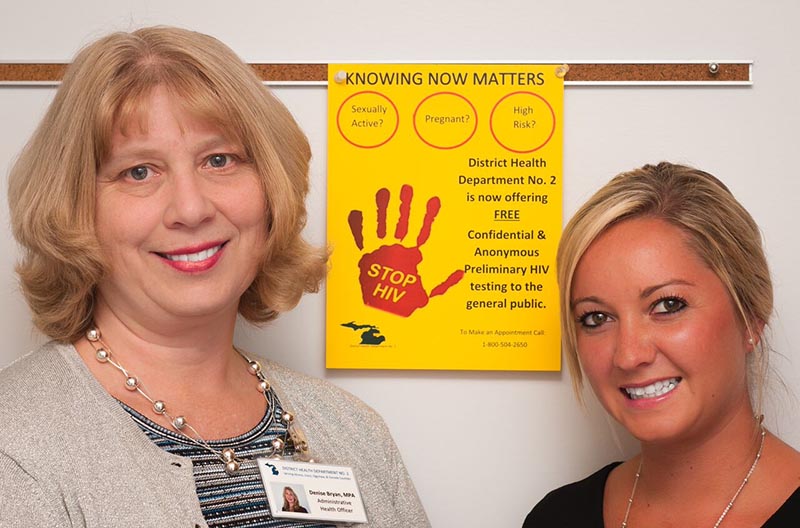Northern Michigan counties vulnerable to HIV, hepatitis C outbreaks

Denise Bryan has a public-health officer’s way of sweeping the gamy details of the human body and its ailments into a conversation the same way she might discuss the weather. It served her well in her last job, in Kent County, where she led efforts to take HIV testing out of the office and into the bars, homeless shelters, gay-pride events and other places where she’d encounter people most at risk for being infected.
But in Ogemaw County, in rural northeast Michigan, Bryan is after a different population.
The Centers for Disease Control and Prevention included Ogemaw County and 10 others in northern Michigan on a list of 220 rural U.S. counties considered “potentially vulnerable” to an HIV outbreak via the sharing of needles used by abusers of heroin or opioid painkillers.
These counties, the CDC warned, shared key characteristics with Scott County, Indiana, where health officials were stunned to learn, in 2015, that HIV was running rampant. Located in southern Indiana about 30 miles north of Louisville, Ky., Scott County is home to about 24,000 people, about half of them in the towns of Scottsburg and Austin. The fast-moving HIV outbreak put it on the national map, as state and local officials grappled with how best to address an infection most often associated with cities, with drug abuse and unsafe sex.
Indiana Gov. Mike Pence, now running for vice-president with Republican nominee Donald Trump, faced a high-profile test when he overcame his personal objections to clean-needle exchanges and signed executive orders allowing them in Scott County, and later, in any other Indiana county that might experience a similar outbreak.
Addicts in that Indiana county were crushing and injecting the opioid painkiller Opana, or oxymorphone, typically prescribed for moderate-to-severe pain. With clean needles available only by prescription in Indiana, the sharing of needles among addicts was widely practiced. New infections of HIV in 2014-15 totaled 181 before the needle exchanges were credited with nearly stopping it cold.
In the wake of the Indiana outbreak, CDC researchers put together a set of indicators that might suggest similarly ripe conditions that exist elsewhere. The study announcing it is yet to be published in the Journal of Acquired Immune Deficiency Syndromes, but the CDC contacted state health officials last August about the 11 Michigan counties that matched the profile.
Katie Macomber, acting division director for HIV/STD programs in the state Department of Health & Human Services, said the news did not come as a complete surprise.
The department knew that hepatitis C, an infection often found in IV drug abusers, has been climbing in northern Michigan. They know opioid abuse is a problem there as well. These counties, all north of Saginaw Bay in the lower peninsula, are also poorer and mainly white, characteristics they share with Indiana’s Scott County.
When Macomber and her colleagues passed the warning along to public-health officials in these counties, “they weren’t surprised, either.”
To be sure, the CDC was only warning of potential outbreaks; like the roadside signs in the region warning of the fire risk near its vast tracts of forest, the news was only that conditions were ripe and just a spark – one needle-sharing user with HIV – could set it ablaze. No cases of HIV have been reported in any of these counties since the alert went out.
Macomber said the department set up a conference call with health officials in the 11 affected counties to explain the CDC’s methodology and discuss strategies to address it, mostly education and testing. Bryan is health officer for District Health Department No. 2, serving Alcona, Iosco, Ogemaw and Oscoda counties, east of I-75; only Iosco wasn’t on the list.
“I have been boots on the ground for years as a health officer,” Bryan said. “Three years ago, I moved from urban to rural northern Michigan. But no matter where people live, they think communicable diseases like this happen someplace else.”
Related: Amid opioid crisis, few doctors use Michigan’s outdated drug monitoring tool
The state offered resources, financial and otherwise, and technical assistance, Macomber said, and local officials were charged with carrying out the effort in their area. Each county was granted $20,000 for brochures, education and other help to get the word out. Health officers were trained in rapid-result HIV tests, which require only a finger stick and can be performed anywhere. And they were taught how to advise IV drug users on the best ways to avoid becoming infected.
It may seem like new territory to cover in Michigan’s vacationland, although the region has its share of poverty, drug use and other social problems. But as in Kent County, Bryan said, she is determined to take the department to the people it serves, and not wait for them to stop by. The state’s grant program enabled the hiring of a visiting nurse, who will make questions about drug use and other risky behaviors part of routine health screening.
“In these small towns, everyone knows everyone,” she said, so many might be unwilling to be seen entering a building with a public health clinic. But a visiting nurse can, in the course of advising residents on child care or nutrition or exercise, slip in a rapid HIV test.
Staff members are learning the importance of cultural competency and sexual health, so they can talk about both sex and drug abuse “in a way that they’re not embarrassed and not judgmental,” Bryan said.
Should the worst happen, and an outbreak occur in one of these counties, Macomber said, the department has the discretion to use a portion of its federal money for needle exchanges, and would not have to wait for a gubernatorial signature as in Indiana. There are already four needle exchanges operating in Michigan, all downstate, in Detroit, Grand Rapids, Flint and Ypsilanti, she said. Users can turn in dirty needles for clean, sterile ones, or receive the latter by request.
But for now the concern is reaching those most at-risk and informing them of how they can protect themselves – through knowledge of their HIV status and avoiding risky behavior – as well as preparing for the worst.
“One recommendation that Indiana came up with after this event was on outbreak response planning,” said Jennifer Eisner, spokeswoman for the state DHHS. Typically, HIV prevention efforts have been about general education about risks and behavior, but less about how to deal with a fast-moving outbreak as happened in Scott County.
“We have spent a lot of time here with an outbreak response plan for the health departments and ourselves,” Eisner said. “The hepatitis C numbers are the canary in the coal mine.”
See what new members are saying about why they donated to Bridge Michigan:
- “In order for this information to be accurate and unbiased it must be underwritten by its readers, not by special interests.” - Larry S.
- “Not many other media sources report on the topics Bridge does.” - Susan B.
- “Your journalism is outstanding and rare these days.” - Mark S.
If you want to ensure the future of nonpartisan, nonprofit Michigan journalism, please become a member today. You, too, will be asked why you donated and maybe we'll feature your quote next time!


 Denise Bryan of West Branch is public health officer for four northern Michigan counties where the potential for an HIV outbreak is high. (Bridge photo by Ted Fines)
Denise Bryan of West Branch is public health officer for four northern Michigan counties where the potential for an HIV outbreak is high. (Bridge photo by Ted Fines) Denise Bryan, a public health officer based in West Branch, is working with Stacy DeBoever to bring rapid-response HIV testing to the four northern Michigan counties they serve, where the CDC has recently warned conditions are ripe for a HIV outbreak. (Bridge photo by Ted Fines)
Denise Bryan, a public health officer based in West Branch, is working with Stacy DeBoever to bring rapid-response HIV testing to the four northern Michigan counties they serve, where the CDC has recently warned conditions are ripe for a HIV outbreak. (Bridge photo by Ted Fines)